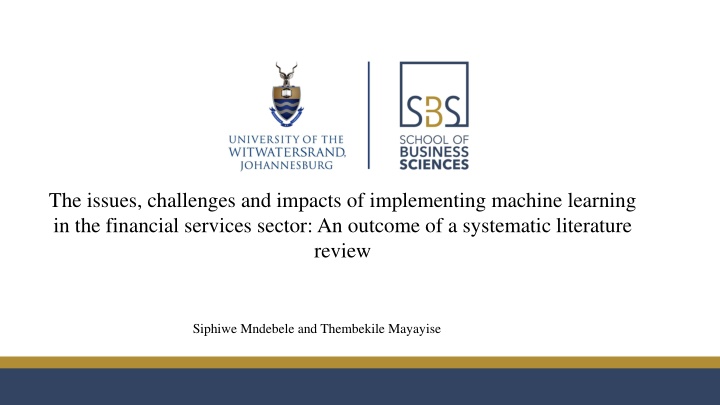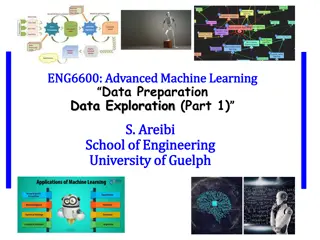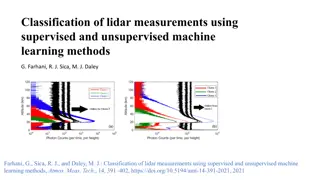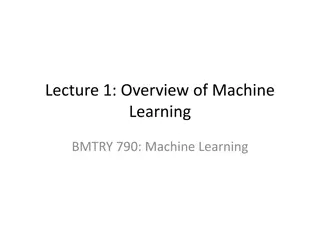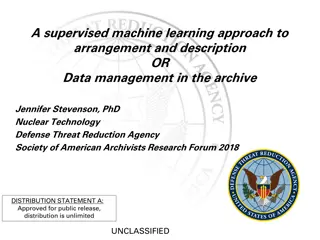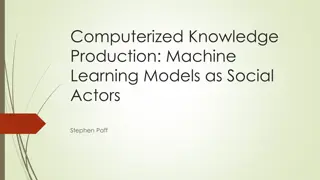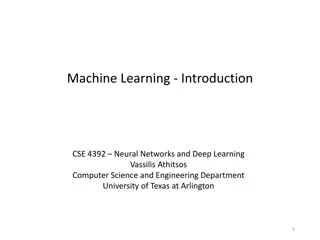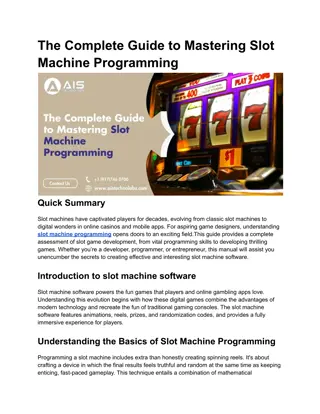Challenges of Implementing Machine Learning in Financial Services
Machine learning plays a crucial role in the financial services sector, impacting areas such as credit risk assessment, fraud detection, and predictive analytics. This systematic literature review explores the issues, challenges, and impacts of implementing machine learning in financial services, highlighting the importance of analytical capability and the growing use of ML techniques in areas like client bankruptcy prediction and risk assessment.
Download Presentation

Please find below an Image/Link to download the presentation.
The content on the website is provided AS IS for your information and personal use only. It may not be sold, licensed, or shared on other websites without obtaining consent from the author.If you encounter any issues during the download, it is possible that the publisher has removed the file from their server.
You are allowed to download the files provided on this website for personal or commercial use, subject to the condition that they are used lawfully. All files are the property of their respective owners.
The content on the website is provided AS IS for your information and personal use only. It may not be sold, licensed, or shared on other websites without obtaining consent from the author.
E N D
Presentation Transcript
The issues, challenges and impacts of implementing machine learning in the financial services sector: An outcome of a systematic literature review Siphiwe Mndebele and Thembekile Mayayise
Outline Background Literature review Methodology Findings Questions
Background Machine learning (ML) involves the capability of systems to use curated algorithms to iteratively learn by training available data sets to establish patterns and make predictions about new data. Since the inception of machine learning in the early 1950s, it has gained so much prominence. ML draws from various fields such as statistics, artificial intelligence, analytics, and optimisation studies. Its use extends to engineering, manufacturing, agriculture, commercial and social settings. The adaptability of machine learning algorithms facilitates the generation of insights from a variety of complex and very large data sets, and this has promoted the adoption of machine learning across a variety of fields.
Research Objectives To uncover the extent to which machine learning has been researched in the context of the issues, challenges, and impacts of implementing ML in the financial services sector and to identify potential areas for future research. Explore the different implementations of ML techniques in the financial services sector to identify, analyse and evaluate the issues, challenges, and impacts of implementing those machine learning models/techniques. Research Questions What are the issues, challenges and impacts of implementing Machine Learning in the financial services sector? Sub-Questions In what financial business contexts are ML technologies implemented? What ML methods/techniques are implemented in each financial business context?
Literature Review Implementing ML is important, especially when financial services institutions require the necessary analytical capability, as the implementation is likely to impact every aspect of their business model. In certain financial services environments, unsupervised ML is often used to explore the complex input data from their clients loan records, where regression and classification methods are used to predict key credit risk variables to determine the risk of clients defaulting on loan payments. Some of the ML challenges include the detection and prevention of credit card fraud . Evidence of studies is growing in understanding the application of various machine learning techniques to predict things such as bankruptcy of clients and businesses, as well as research into the use of ML methods to evaluate risk assessment in the banking sector.
Methodology Inclusion and exclusion criteria Included Excluded Scope of coverage: 2013-2022 Literature published before 2013 and after 2022 is excluded Non-Machine learning-related content Exposure of interest: machine learning, business analytics, predictive analytics, artificial or business intelligence with a specific focus on machine learning Language: English Source of literature: scholarly books, journal articles, conference proceedings, and grey literature, including dissertations and theses Non-English written Any literature not in the form of scholarly books, journal articles, conference proceedings, and grey literature, including dissertations and theses. Unspecified study design Study Design: include quantitative, qualitative, and mixed-methods studies Databases: Science Direct, ProQuest and Ebsco Host
Methodology PRISMA
Findings No of articles per financial services sector RISK MANAGEMENT 4 Machine Learning use GENERAL 5 FRAUD DETECTION 7 FORECASTING STOCK MARKET PERFORMANCE 5 CREDIT DEFAULT PREDICTION 6 BANKRUPTCY 8 0 1 2 3 4 5 6 7 8 9 No.of articles
Findings Breakdown of common machine learning models per financial services sector 100% 90% 80% 70% 60% 50% 40% 30% 20% 10% 0% Bankruptcy prediction Credit default prediction Forecasting stock market performance Fraud detection Risk Management Support Vector Machine Neural Network Ensemble/Hybrid Deep learning Clustering Machine language uses in the financial services sector. Bankruptcy(hybrid/support vector) Fraud Detection(Support vector/neural/hybrid) Credit Default Prediction(support vector/hybrid/clustering) Forecasting stock market performance(neural/hybrid) Risk management(support vector/neural)
Codes Sub-Themes General theme
References Marr, B. (2016). What Is The Difference Between Artificial Intelligence And Machine Learning? Forbes. https://www.forbes.com/sites/bernardmarr/2016/12/06/what-is-the- difference-between-artificial-intelligence-and-machine-learning/. Agavanakis, K. N., Karpetas, George. E., Taylor, M., Pappa, E., Michail, C. M., Filos, J., Trachana, V., & Kontopoulou, L. (2019). Practical machine learning based on cloud computing resources. AIP Conference Proceedings, 2123(1), 020096 1. asn. Akter, S., & Wamba, S. F. (2016). Big data analytics in E-commerce: A systematic review and agenda for future research. Electronic Markets, 26(2), 173 194. https://doi.org/10.1007/s12525-016-0219-0 Devi, S. S., & Radhika, Y. (2018). A survey on machine learning and statistical techniques in bankruptcy prediction. International Journal of Machine Learning and Computing, 8(2), 133 139. Drucker, A. M., Fleming, P., & Chan, A.-W. (2016). Research Techniques Made Simple: Assessing Risk of Bias in Systematic Reviews. Journal of Investigative Dermatology, 136(11), e109 e114. https://doi.org/10.1016/j.jid.2016.08.021 Hagen-Zanker, J., & Mallett, R. (2013). How to do a rigorous, evidence-focused literature review in international development: A guidance note. London: Overseas Development Institute.
